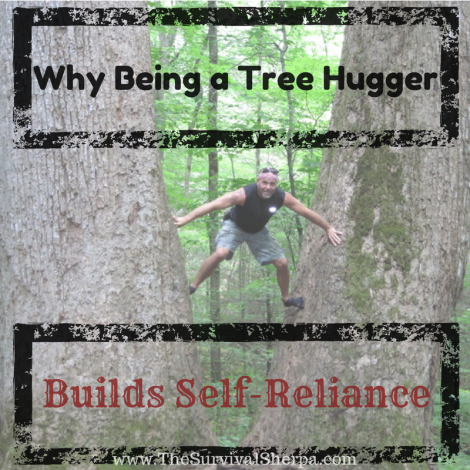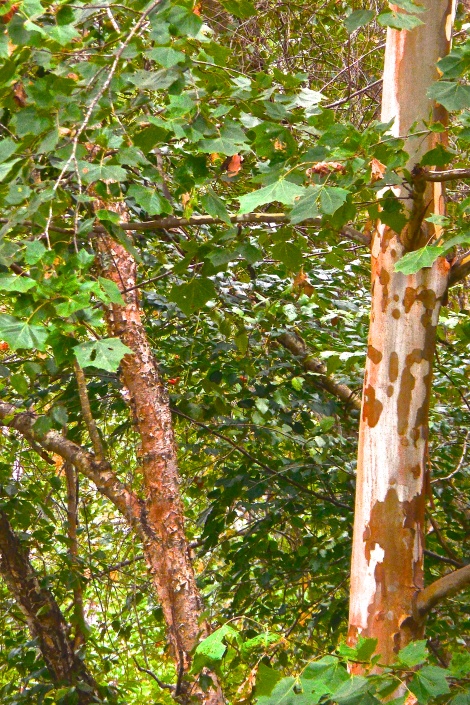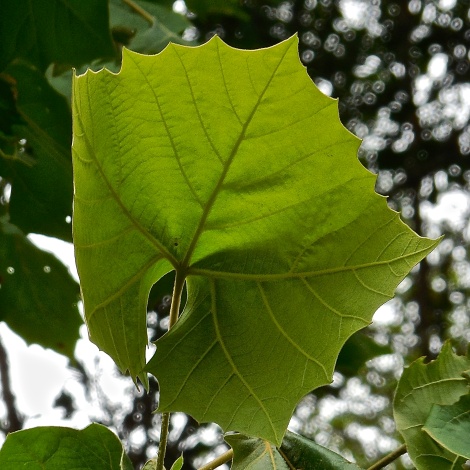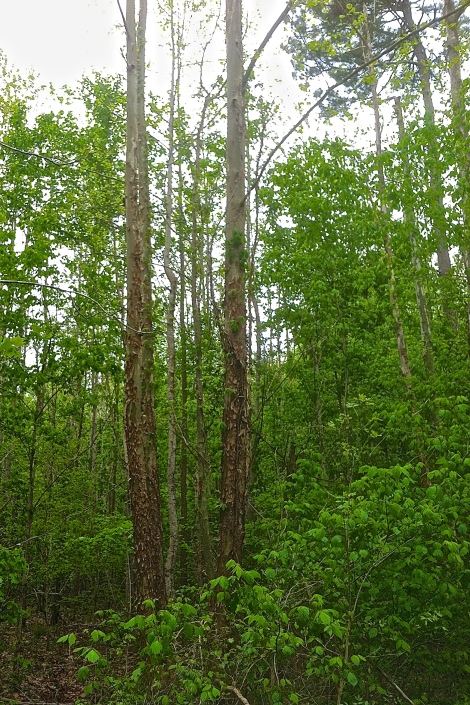by Todd Walker
I’ve never considered myself a “tree hugger” as defined in the Merriam-Webster dictionary:
noun: someone who is regarded as foolish or annoying because of being too concerned about protecting trees, animals, and other parts of the natural world from pollution and other threats [Emphasis mine]
Yesterday I annoyed a few motorists crossing a narrow country bridge on a tree hugger outing. Not intentionally, mind you. It’s just that I needed to photograph a beautiful American Sycamore stretching its molten limbs over a muddy Georgia river. One trucker let me know how foolish I looked by blaring his air horn as I perched on the bridge railing snapping my shutter. Unaffected, I continued my craziness.
The thought of being a tree hugger, as previously defined, may not describe you, but every person on the journey to self-reliance and preparedness would benefit from hugging a tree or two.
You’re conflicted, right? Well, don’t be.
It’s our responsibility to protect, use, and conserve our natural resources. We’re stewards of this land. Our Appalachian ancestors understood the properties of trees and how to use the wood, bark, leaves, and roots to build a sustainable life. There were no box stores with stacks of dimensional lumber to build a house. If a handle shattered, they knew the best wood to use for re-hafting an ax. Tulip Poplar was abundant and used to build houses and hand-hewn log cabins. The Appalachian pioneers knew their wood!
There are boat-loads of info on edible weeds and medicinal plants. I’ve found a lack of printed material on the medicinal/edible uses of trees. I have many of the Foxfire book series and always look to add more to my self-reliance library. Clue me in if you have more tree resource books, please. So, like any good Doer of the Stuff, I’m embarking (pun intended) on a tree education journey as part of my Doing the Stuff Skills list. Who knows, maybe you’ll be convinced to embrace your inner tree hugger.
Ready, set, hug!
The first tree to wrap your arms around is the American Sycamore (Platanus occidentalis). It can reach heights over 130 tall, over 10 feet in diameter, and grow to be 600 years old. George Washington documented in his journal in 1770 a sycamore with a diameter of 14 feet (45 feet in circumference). Trees this large usually have hollow trunks that house animals of all sorts. It’s been reported that settlers even used hollowed Sycamore trees to shelter livestock.
The rapid growth rate of this deciduous tree causes the bark to shed in molten fashion like a birch tree. Its camouflage pattern of light green and brownish gray with creamy white background splotches causes the trunk to stand out in late fall and winter when forest leaves lay on the ground. The exfoliating bark and coloration makes the sycamore one of the easiest deciduous trees in the eastern woodlands to identify in the winter.
The Sycamore and Self-Reliance
The fast growing American Sycamore likes wet bottom land near streams, rivers and ponds in full sun. Their leaves are similar to maple but not as spectacular since they turn a boring brown in the fall. Beavers find the bark appetizing.
In Bushcraft
Bushcraft refers to the art of crafting in the bush (woods) with minimal tools and lots of skill.
- Sycamore’s fibers intertwine making it an excellent wood for spoon and bowl carving. The wood tends to warp in the drying process, so use dried, seasoned wood.
- Not rot resistant and shouldn’t be used for longterm structures exposed to the moisture.
- The sap offers a year-round source of hydration in warm climates.
- The sycamore can also be tapped like a maple tree for syrup or sugar. However, it takes a lot of sap to make small batches of sycamore syrup.
- Shade-casting crown of large trees offer shelter from the sun.
- Large leaves (up to 10 inches across) can be used as a wrap for slow cooked food over coals for an added sweet flavor.
In Woodwork
- Sycamore is grown commercially for pulp and rough lumber.
- Interlocking grain makes nice accent pieces for woodworking.
- Turns easily on a lathe for bowls.
- Beautiful specking on gun stocks.
- Music boxes; guitars and violins.
- Hard to split which makes sycamore an excellent butcher’s block.
- Quarter sawn makes this wood more stable for projects. Flat sawn tends to warp.
- It gets one of its nicknames “Buttonwood” from it ability to create durable wooden buttons.
- The wood is food safe and was used for food crates and barrels in the past.
In Medicine
Inner bark tee was used for a wide variety of treatments by Native Americans.
- Colds, coughs, and lung ailments
- Measles
- Emetic – cause vomiting
- Laxative
- Astringent properties to treat skin issues and eye wash
- Sweet sap on the inner bark used for wound dressing
- Sap can also be used to make wine
The American Sycamore is a pioneer species. About forty years ago, we stopped cultivating a small field on wet bottom land on our family farm. Today we have a large stand of native sycamores growing wild.
Being a “tree hugger” should not carry a negative stereotype or denote a political affiliation for those of us building self-reliance skills and pursuing a more sustainable lifestyle. Embrace your love of trees and learn to be stewards of these towers of the forest!
Have you hugged a tree today?
Keep Doing the Stuff of Self-Reliance,
Todd
P.S. – You can also keep up with the Stuff we’re Doing on Twitter, Pinterest, Google +, and our Facebook page… and over at the Doing the Stuff Network on Pinterest, Google +, and Facebook.
P.P.S – If you find value in our blog, Dirt Road Girl and I would appreciate your vote on Top Prepper Sites! You can vote daily by clicking here or on the image below. Check out all the other value-adding sites while you’re there…
Thanks for Sharing the Stuff!
Copyright: Content on this site (unless the work of a third-party) may be shared freely in digital form, in part or whole, for non-commercial use with a link back to this site crediting the author. All links in articles must remain intact as originally posted in order to be republished. If you are interested a third-party article, please contact the author directly for republishing information.














Permaculture and forest gardens are definitely a part of being self-sufficient. During times of unrest, the forest becomes the place people “hid” their food from groups of people — sometimes the state — that would take their food supplies and leave them to starve. Forest gardens take the forest, which in many places doesn’t produce much food for people, and makes the natural forest into a food and medicine producing garden. Forest gardens can also produce food for livestock and fungus. Forest gardens also hides the food, medicine and animal products from people that would steal your food and leave you to starve. (If you don’t believe this can happen research the Holodomor — Hunger-extermination– which killed about 4 million Ukrainians.)
Here’s two books I like about forest gardening: Edible Forest Gardens: 2 Volume Set by David Jacke and Restoration Agriculture: Real World Permaculture for Farmers by Mark Shepard. The second book talks about using “keylines” to make water sit and “hide” on your property. In the future, control of water is going to be a major issue for the private property owner, unless we can fight control of it away from the the state. A third book I am reading right now is Growing Gourmet and Medicinal Mushrooms by Paul Stamets. Mushrooms can be a major food source in a forest garden. Only the knowledgeable will know which mushrooms are food and medicine and which mushrooms will cause liver failure.
There are two things I do not like about permaculture. One is the focus on socialistic community structure. Many permaculturists seem to disregard the basic family structure and hate the concept of private property. The second problem with permaculture is the focus on environmental religious beliefs. This all started with James Locklock’s “Gaia Hypothesis” which states that the planet is a life form. The earth is a very complex system but it doesn’t pass the most basic requirement of a life form — the ability to reproduce. The Gaia hypothesis isn’t science, it’s religion. It’s a very dangerous religion too because at its base is a hatred of humanity because humanity is killing Mother Earth.
The Gaia believers think we need an extreme form of government to control humanity to save the planet. Extreme measures of control are required which only a world government could implement. UN Agenda 21 is one example of the fruit of this environmental religion, pretending to be science. If they get their way, you will be forced to live in an environmental gulag run by wise ecological planners, without private property because you are too stupid to make good choices for Gaia.
LikeLike
You warned me about Agenda 21 a year ago. Basically, the Gaia crew are statists on steroids… with faux science backing them. Have you done a post on this, Caroline?
LikeLike
No, I haven’t really processed all the information yet. It’s also painful for me being a reformed, environmental true believer. The closest I have come to writing about the situation is in the Sustainable System Series. The essay on Ecofascism should be required reading for everyone that loves freedom: http://eatkamloops.org/sustainable-system-series/.
LikeLike
Michael Crichton also wrote some essays that should be required reading on how certain factions of environmentalism have become a religion. This is not to say that environmentalism itself is religion, but that for some people, it is a religion. Basically it mimics conventional Christianity. You have a time of peace and harmony in which humans supposedly lived in harmony with nature (akin to Adam and Eve in the Garden of Eden), a moment of sin when Man began manipulating nature to his own benefit (akin to Eve eating the apple), and then the coming doomsday, where we will all die due to our sins against the Earth (akin to revelations). This is likely because the human brain is so hardwired for religion that a lot of people who reject religions such as Christianity end up becoming instead very religious in terms of something that they do not even recognize to be a religion, i.e. the environment.
LikeLike
This is awesome! Trees are a great recourse because (depending on what you use them for), they will most likely be there the next time you come by, thus having a very reliable source of medicine (or food). They are also an under “explored” and written about subject, like you said.
LikeLike
Exactly, Chewy! They aren’t seasonal like some medicinal plants. Learning to identify deciduous trees – even in winter – is a great skill to learn.
LikeLike
Wow! What a great article. So much information here. Thanks!
LikeLike
Appreciate the kind words, brother! BTW Mike, added you to our Trusted Resources Page under the Doing the Stuff Network.
LikeLike
Thank you sir! I enjoy reading the helpful information on your site … it’s honor to be considered.
LikeLiked by 1 person
This is a great post! It takes me back to summer Saturdays as a boy under the three-in-a-row sycamores in my back yard. About 30 or 40 feet tall, their canopies gave wonderful shade and the forked trunks made excellent playgrounds for a boy.
The info about syrup production is something i never knew! Thanks a lot for this, Todd.
LikeLike
Thank, tinkicker! Glad you liked it and took the time to comment.
LikeLike
Pingback: Why Being a “Tree Hugger” Builds Self-Reliance - Prepared Bloggers
Pingback: Spoon Carving with an Ax | Survival Sherpa
Pingback: Spoon Carving with an Ax | The Daily Sheeple
Pingback: Spoon Carving with an Ax | Alternative News Network
Pingback: Spoon Carving with an Ax - Trendingnewsz.com
Pingback: Spoon Carving with an Ax | Ready Nutrition
Pingback: Spoon Carving with an Ax » Survival Gear & Food Storage
Pingback: Spoon Carving with an Ax | TheSurvivalPlaceBlog
Pingback: Best Practices for Your Third Most Critical Survival Priority | Survival Sherpa
Pingback: Best Practices for Your Third Most Critical Survival Priority - Prepper Ways